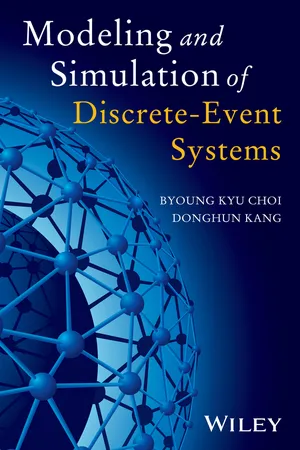We think by “constructing mental models and then simulating them in order to draw conclusions or make decisions.” Thus, modeling and simulation (M&S) constitutes the central part of our thinking process. “I think, therefore I am” is a philosophical statement used by the French philosopher Descartes, which became a foundational element of Western philosophy. Therefore, if we combine the philosophical notion of thinking with the engineering definition of M&S, we may say that “we are engineers and scientists because we can model systems and simulate them.” Furthermore, if our brain is not powerful enough to simulate a given complex system, we rely on computers to perform a computer simulation.
A dictionary definition of simulation is the technique of imitating the behavior of some situation by means of an analogous situation or apparatus to gain information more conveniently or to train personnel, while an academic definition of computer simulation is the discipline of designing a model of a system, simulating the model on a digital computer, and analyzing the execution output. In recent years, the term modeling and simulation (M&S) seems to be preferred to the term for computer simulation, with an emphasis on modeling. Part I of this book has two chapters, and it aims to provide the readers with a basic but comprehensive treatment of computer simulation.
Chapter 1, “Overview of Computer Simulation,” will provide answers to the following basic questions in computer simulation:
1. What is a system?
2. What is computer simulation?
3. What is discrete-event simulation?
4. What is continuous simulation?
5. What is Monte Carlo simulation?
6. What are simulation experimentation and optimization?
Chapter 2, “Basics of Discrete-Event System Modeling & Simulation,” aims to provide answers to the following basic questions in discrete-event system (DES) M&S:
1. How is a discrete-event simulation carried out?
2. What are modeling components and a reference model?
3. What is a discrete-event system modeling formalism?
4. What is a formal model and how it is specified?
5. What is the integrated framework of discrete-event system modeling?
6. How do we build and simulate an event graph or activity cycle diagram (ACD) model of a DES?
7. How is the M&S life cycle managed?
1.1 Introduction
Richmond [2003] defines thinking as “constructing mental models and then simulating them in order to draw conclusions or make decisions.” Namely, he defines thinking as mental simulation. When the situation is too complex to be analyzed by mental simulation alone, we rely on computer simulation. According to Schruben [2012], simulation models provide unlimited virtual power: “If you can think of something, you can simulate it. Experimenting in a simulated world, you can change anything, in any way, at any time—even change time itself.”
Fishwick [1995] defines computer simulation as the discipline of designing a model of a system, simulating the model on a digital computer, and analyzing the execution output. In the military, where computer simulation is extensively used in training personnel (e.g., war game simulation) and acquiring weapon systems (e.g., simulation-based acquisition), the term modeling and simulation (M&S) is used in place of computer simulation. In this book, these two terms are used interchangeably.
The purpose of this chapter is to provide the reader with a basic understanding of computer simulation. After studying this chapter, you should be able to answer the following questions:
1. What are the common characteristics that lead to a conceptual definition of system?
2. What are the three types of systems?
3. What are the three subsystems in a feedback control system?
4. What are the three types of virtual environment simulation?
5. What are the three types of computer simulation?
6. What is the simulation model trajectory of a discrete-event system?
7. What is Monte Carlo simulation?
8. What is sensitivity analysis in simulation experimentation?
This chapter is organized as follows: Definitions and structures of systems are given in Section 1.2. Section 1.3 provides definitions and applications of simulation. The subsequent three sections introduce the three simulation types: discrete-event simulation in Section 1.4, continuous simulation in Section 1.5, and Monte Carlo simulation in Section 1.6. Finally, a basic framework of simulation experimentation is presented in Section 1.7.
1.2 What Is a System?
1.2.1 Definitions of Systems
Systems are encountered everywhere in the world. While those systems differ in their specifics, they share common characteristics that lead to a conceptual definition of a system. In Wu [1992], a system is defined as “a collection of components which are interrelated in an organized way and work together towards the accomplishment of certain logical and purposeful end.” Thus, any portion of the real world may be defined as a system if it has the following characteristics: (1) it has a purpose or purposes, (2) its components are connected in an organized manner, and (3) they work together to achieve common objectives. A system consisting of people is often called a team. Needless to say, a mere crowd of people sharing no common objectives is not a team.
When defining a system, the concept of state variable plays a key role. A state variable is a particular measurable property of an object or system. Examples of state variables are the number of jobs in a buffer, status of a machine, temperature of an oven, etc. A system in which the state variables change instantaneously at discrete points in time is called a discrete-event system, whereas a system in which state variables change continuously over time is called a continuous system.
1.2.2 Three Types of Systems
Our universe, which is full of systems everywhere, may be viewed from the five levels of detail (Fig. 1.1): from the subatomic level to cosmological level. In the subatomic level, interactions among the components of a system are described using quantum mechanics, which is a physical science dealing with the behavior of matter and energy on the scale of atoms a...
